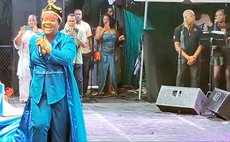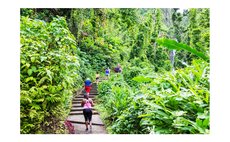An intriguing stroll through Roseau
It's a cool Saturday afternoon; the traffic is light with only a handful of people bringing their day to a close in Roseau -- a good time for a leisurely stroll through the capital.
And doing so with someone who has intimate knowledge of Roseau helps one to see it with new eyes.
The guide for this walk is Jacqueline Dupigny, a founding member of the Society for Heritage Preservation and Enhancement (SHAPE).
Jackie leads the way through narrow streets where concrete 'boxes' stare blankly down; their facades have replaced many of the charming old buildings and seem to shoulder those that remain, out of the way. Undoubtedly, these new buildings have significantly altered the streetscape.
Still, there is much to be seen of the island's Creole architecture. Like in many parts of the Caribbean, the local architecture is a combination of styles. Here, it is a blend of European, African and pre-Columbian America architecture with local elements, according to a SHAPE brochure. The brochure also informs that the construction materials of Roseau's original buildings were local hardwoods which are dense and therefore resistant to termites and weather. Later, cut volcanic stone was used for ground floors.
As the walk unfolds, Jackie identifies interesting features of properties.
There are many treasures along the way and even the cobblestone sidewalks and lanes are cultural jewels, laid by slave ancestors. Dominica, she believes, is one of the last Caribbean islands in which the original cobblestone sidewalks and lanes have survived.
She points to a wrought iron verandah on her family's building on Long Lane, a feature she said, of New Orleans architecture. As the story goes, the particular pieces of pre-fabricated wrought iron used for this verandah were destined for New Orleans and had to be offloaded here because of a hurricane.
Three homeowners in Roseau used the wrought iron for their verandas. One of the properties was on Old Street but was destroyed by fire. The other property, the original Jolly's pharmacy, is on King George V Street.
Many buildings around Roseau bear similar verandas made of metal. Others have wooden verandas adorned with gingerbread fretwork (a remnant of the Victorian era), a common characteristic of Caribbean architecture.
Some of the Roseau buildings still bear the old wooden picturesque jalousie windows which are being quickly sidelined with modern fixtures.
Along the cobbled John's Lane, Jackie singles out a stone building belonging to the Rolle family. Its arched entrances border one side of the Street. This was Dominica's first jail built under the French. Today it is a domestic residence and little remains to identify it as a former penitentiary.
Additionally, John's Lane, as well as nearby Love's Lane, was used to dry vanilla in the days when Dominica was a leading producer.
Along Old Street, she turns her attention above where metal from old railway tracks was used for the veranda's support structure. She was able to pinpoint another similar example on Church Street.
Historian, Dr Lennox Honychurch states that Dominica's only railway was built on the lower slopes of Morne Diablotin for Forest Ltd to transport logs. The railway was demolished after Forest Ltd folded in 1913.
Another architectural feature of Old Roseau that has persevered is the arched gateway, many examples of which can still be seen in the capital. Jackie explains that the entrances were constructed in this fashion to allow for access by horses during the colonial days.
She further reveals that though many of the properties in Roseau appear clustered when viewed from the street, the magnitude of the backyard space can be surprising. In fact, there is a tennis court aback one cottage on Virgin Lane!
Other than the arched entrances, the walk frequently takes us past another common feature of Roseau: basements with slanted doorways. These basements were used to store much of the agricultural produce of the plantations. They were stored there until the ships came to port, Dr Honychurch explained. Today, many business operators still make use of these cellars.
Dr Honychurch noted that basements were carefully designed so that they would not go below the water table since rivers run under the town. In fact, some Roseau property owners were lucky enough to have their own fresh water wells in the heart of the city, according to Dr Honychurch.
Preservation
Jackie and another member of SHAPE, Juliet Shillingford-Fadelle, agree that much can be done to preserve the architecture of Roseau and Dominica in general.
SHAPE was established in 1996 with a view to doing just that but gradually became dormant.
Shillingford-Fadelle laments the fact that so many of the old buildings have been torn down and replaced with faceless structures. But they still believe that SHAPE managed to make an impact on the consciousness of Dominicans. Both women are relieved that some business owners have made an effort to blend the Creole style architecture with modern architecture. This is evident in the design of the buildings housing Perky's Pizza, Burton & Company, Fort Young Hotel, Singoalla Bloomquist offices and La Falaise Laboratory.
Shillingford-Fadelle looks forward to seeing the Cultural Division and even Discover Dominica Authority doing more to preserve Dominica's architectural heritage which she is convinced is an economic resource that can benefit the island significantly.
By Gwen Evelyn




